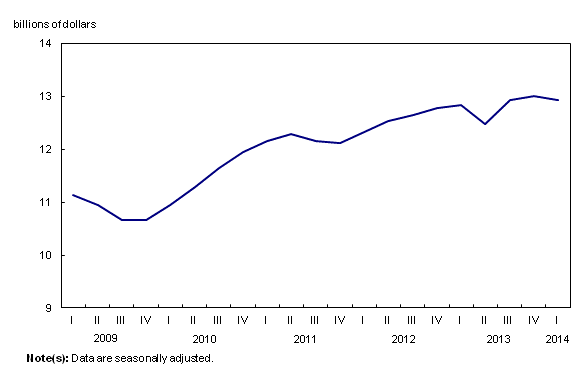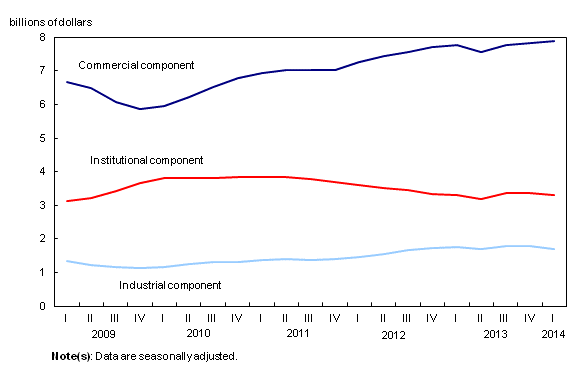Investment in non-residential building construction, first quarter 2014
Archived Content
Information identified as archived is provided for reference, research or recordkeeping purposes. It is not subject to the Government of Canada Web Standards and has not been altered or updated since it was archived. Please "contact us" to request a format other than those available.
Released: 2014-04-16
Investment in non-residential building construction was down 0.6% from the previous quarter to $12.9 billion in the first quarter. This decline followed two consecutive quarterly gains and was largely attributable to lower spending in the construction of industrial and institutional buildings.
Investment fell in five provinces in the first quarter. The largest decreases occurred in Quebec and British Columbia. Investment in Quebec was down in the commercial and industrial components, while British Columbia's investment fell in the industrial, commercial and institutional components.
In contrast, Ontario, Alberta and Saskatchewan recorded the largest gains in the first quarter, mainly as a result of higher spending on commercial construction projects.
Census metropolitan areas
Investment was down in 21 of 34 census metropolitan areas in the first quarter. The largest declines occurred in Montréal, London and Vancouver. In Montréal, the decrease resulted from lower commercial and industrial investments, while in London and Vancouver all three components were down.
Toronto posted the largest increase in the first quarter, as investment rose 4.3% to $2.5 billion. The increase was due to advances in the commercial and industrial components.
Commercial component
Spending in commercial building construction was up in five provinces, rising 0.8% to $7.9 billion in the first quarter. It was the third consecutive quarter of growth and was led by higher spending in the construction of office and recreational buildings.
Ontario was by far the main contributor to the increase in commercial investment, followed by Alberta. In Ontario, investment rose 5.0% to $3.0 billion, mostly as a result of higher spending on office buildings. In Alberta, commercial investment was up 3.0% to $1.9 billion, a second consecutive quarter of increase. Alberta's gain was mostly a result of higher spending in the construction of office buildings, retail and wholesale outlets and hotels.
Conversely, the largest declines occurred in Quebec, where investment fell 7.2% to $1.4 billion, as a result of lower spending in several commercial building categories.
Institutional component
In the institutional component, investment declined in eight provinces, falling 1.6% to $3.3 billion in the first quarter.
Ontario posted the largest decline, where investment fell 5.3% to $1.3 billion, the ninth consecutive quarterly decline. The decrease was mainly attributable to lower spending in the construction of educational buildings and, to a lesser extent, government buildings and nursing homes.
In contrast, Quebec and New Brunswick registered gains in the first quarter, primarily as a result of higher spending on the construction of health care facilities.
Industrial component
Investment in the industrial component decreased 5.4% to $1.7 billion in the first quarter. This was mainly the result of lower spending on the construction of maintenance buildings and primary industry buildings.
Overall, six provinces posted declines in the industrial component. The biggest declines were in Quebec and Alberta, largely as a result of lower spending on maintenance buildings.
The biggest increase occurred in Newfoundland and Labrador, followed by Saskatchewan. In Newfoundland and Labrador, investment rose 29.1% to $22 million, mostly a result of higher spending on the construction of maintenance and utility buildings. In Saskatchewan, investment increased 6.9% to $69 million, the fourth consecutive quarterly gain, mainly as a result of higher spending on utility buildings.
Note to readers
Unless otherwise stated, this release presents seasonally adjusted data expressed in current dollars, which facilitates comparisons by removing the effects of seasonal variations. For more information on seasonal adjustment, see "Seasonal adjustment and identifying economic trends."
Investments in non-residential building construction exclude engineering construction (such as for highways, sewers, bridges and oil and gas pipelines). This series is based on the Building Permits Survey of municipalities, which collects information on construction intentions.
Work put-in-place patterns are assigned to each type of structure (industrial, commercial and institutional). These work patterns are used to distribute the value of building permits according to project length. Work put-in-place patterns differ according to the value of the construction project; a project worth several million dollars will usually take longer to complete than will a project of a few hundred thousand dollars.
Additional data from the Capital and Repair Expenditures Survey are used to create this investment series. Investments in non-residential building data are also benchmarked to Statistics Canada's System of National Accounts' non-residential building investment series.
For the purpose of this release, the census metropolitan area of Ottawa–Gatineau (Ontario/Quebec) is divided into two areas: the Ottawa part and the Gatineau part.
Contact information
For more information, contact us (toll-free 1-800-263-1136; 514-283-8300; infostats@statcan.gc.ca).
To enquire about the concepts, methods or data quality of this release, contact Mahamat Hamit-Haggar (613-951-0862), Investment, Science and Technology Division.
- Date modified:



